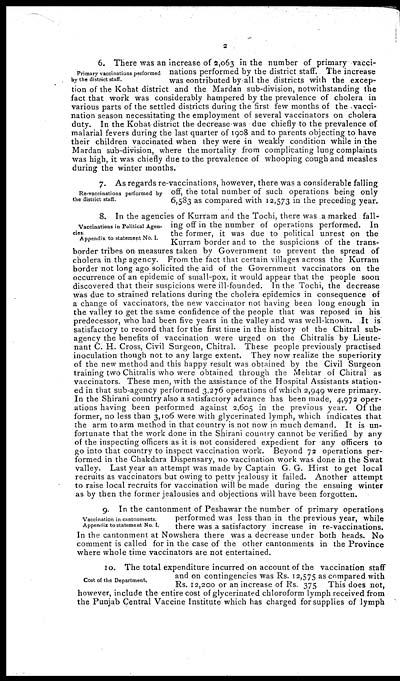Medicine - Vaccination > 1904-1928 - Report on vaccination in the North-West Frontier Province > Report on vaccination North-West Frontier Province 1904-1922 > Report on vaccination in the North-West Frontier Province for the year 1908-1909
(116) Page 2
Download files
Individual page:
Thumbnail gallery: Grid view | List view

2
Primary vaccinations performed
by the district staff.
6. There was an increase of 2,063 in the number of primary vacci-
nations performed by the district staff. The increase
was contributed by all the districts with the excep-
tion of the Kohat district and the Mardan sub-division, notwithstanding the
fact that work was considerably hampered by the prevalence of cholera in
various parts of the settled districts during the first few months of the vacci-
nation season necessitating the employment of several vaccinators on cholera
duty. In the Kohat district the decrease was due chiefly to the prevalence of
malarial fevers during the last quarter of 1908 and to parents objecting to have
their children vaccinated when they were in weakly condition while in the
Mardan sub-division, where the mortality from complicating lung complaints
was high, it was chiefly due to the prevalence of whooping cough and measles
during the winter months.
Re-vaccinations performed by
the district staff.
7. As regards re-vaccinations, however, there was a considerable falling
off, the total number of such operations being only
6,583 as compared with 12,573 in the preceding year.
Vaccinations in Political Agen-
cies.
Appendix to statement No. I.
8. In the agencies of Kurram and the Tochi, there was a marked fall-
ing off in the number of operations performed. In
the former, it was due to political unrest on the
Kurram border and to the suspicions of the trans-
border tribes on measures taken by Government to prevent the spread of
cholera in the agency. From the fact that certain villages across the Kurram
border not long ago solicited the aid of the Government vaccinators on the
occurrence of an epidemic of small-pox, it would appear that the people soon
discovered that their suspicions were ill-founded. In the Tochi, the decrease
was due to strained relations during the cholera epidemics in consequence of
a change of vaccinators, the new vaccinator not having been long enough in
the valley to get the same confidence of the people that was reposed in his
predecessor, who had been five years in the valley and was well-known. It is
satisfactory to record that for the first time in the history of the Chitral sub-
agency the benefits of vaccination were urged on the Chitralis by Lieute-
nant C. H. Cross, Civil Surgeon, Chitral. These people previously practised
inoculation though not to any large extent. They now realize the superiority
of the new method and this happy result was obtained by the Civil Surgeon
training two Chitralis who were obtained through the Mehtar of Chitral as
vaccinators. These men, with the assistance of the Hospital Assistants station-
ed in that sub-agency performed 3,276 operations of which 2,949 were primary.
In the Shirani country also a satisfactory advance has been made, 4,972 oper-
ations having been performed against 2,605 in the previous year. Of the
former, no less than 3,106 were with glycerinated lymph, which indicates that
the arm to arm method in that country is not now in much demand. It is un-
fortunate that the work done in the Shirani country cannot be verified by any
of the inspecting officers as it is not considered expedient for any officers to
go into that country to inspect vaccination work. Beyond 72 operations per-
formed in the Chakdara Dispensary, no vaccination work was done in the Swat
valley. Last year an attempt was made by Captain G. G. Hirst to get local
recruits as vaccinators but owing to petty jealousy it failed. Another attempt
to raise local recruits for vaccination will be made during the ensuing winter
as by then the former jealousies and objections will have been forgotten.
Vaccination in cantonments.
Appendix to statement No. I.
9. In the cantonment of Peshawar the number of primary operations
performed was less than in the previous year, while
there was a satisfactory increase in re-vaccinations.
In the cantonment at Nowshera there was a decrease under both heads. No
comment is called for in the case of the other cantonments in the Province
where whole time vaccinators are not entertained.
Cost of the Department.
10. The total expenditure incurred on account of the vaccination staff
and on contingencies was Rs. 12,575 as compared with
Rs. 12,200 or an increase of Rs. 375 This does not,
however, include the entire cost of glycerinated chloroform lymph received from
the Punjab Central Vaccine Institute which has charged for supplies of lymph
Set display mode to: Large image | Zoom image | Transcription
Images and transcriptions on this page, including medium image downloads, may be used under the Creative Commons Attribution 4.0 International Licence unless otherwise stated. ![]()
| Permanent URL | https://digital.nls.uk/90618927 |
|---|
| Attribution and copyright: |
|
|---|



![[Page 1]](https://deriv.nls.uk/dcn4/9061/90618926.4.jpg)
